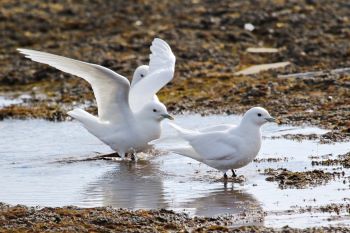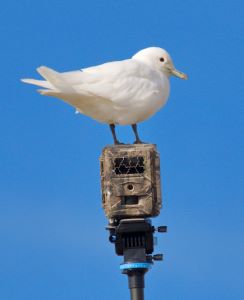Please activate JavaScript in your browser to use all interface options.
Rosneft Completes Summer Field Survey of the Ivory Gull in the Kara Sea
06 October 2022
As part of Rosneft’s biodiversity conservation programme, summer field studies of the Ivory gull population in the north-eastern part of the Kara Sea were completed. The Ivory gull is a rare and protected species included in the Red Book of the Russian Federation and the Red List of the International Union for Conservation of Nature
Environmental protection is one of the key priorities for Rosneft Oil Company in its operations. The Company implements a number of initiatives designed to preserve and restore natural resources, as well as to study arctic species – the most important bioindicators of the state of the environmental. Since 2020, Rosneft has been studying and monitoring the status of key species – indicators of the sustainable state of Arctic marine ecosystems and the ecosystems of the northern territories of Siberia – the wild reindeer, polar bear, walrus and Ivory gull as part of the national Ecology Project.
 Rosneft’s Arctic Research Centre is working with the Arctic and Antarctic Research Institute to study the Ivory gull population. In 2022 observations were carried out in one of the key areas of the birds’ range in the Kara Sea, on Wiese Island, and eight other previously known nesting sites were surveyed. During the expedition, scientists assessed the numbers, health status of the population, nesting characteristics and trophic relationships of the species. Specialists conducted research, collected biomaterial samples and ringed 129 adult birds and 20 chicks. In addition, GPS trackers were placed on the gulls to identify the feeding areas of the birds. The laboratory will carry out analyses of the biomaterials taken, including isotopic, haematological and other analyses. Scientists have also been able to follow the dynamics of the colonies and make video recordings of the nesting behaviour of ivory gulls using camera traps and drones.
Rosneft’s Arctic Research Centre is working with the Arctic and Antarctic Research Institute to study the Ivory gull population. In 2022 observations were carried out in one of the key areas of the birds’ range in the Kara Sea, on Wiese Island, and eight other previously known nesting sites were surveyed. During the expedition, scientists assessed the numbers, health status of the population, nesting characteristics and trophic relationships of the species. Specialists conducted research, collected biomaterial samples and ringed 129 adult birds and 20 chicks. In addition, GPS trackers were placed on the gulls to identify the feeding areas of the birds. The laboratory will carry out analyses of the biomaterials taken, including isotopic, haematological and other analyses. Scientists have also been able to follow the dynamics of the colonies and make video recordings of the nesting behaviour of ivory gulls using camera traps and drones.
Data from field observations and laboratory tests will be systematised and analysed during the office study. The experts will be able, for the first time, to assess the stress levels of the Ivory gull population and analyse the condition of the habitats. The results will contribute to the conservation of this rare species, improve monitoring techniques and fill gaps in scientific knowledge of the Ivory gull.
Note for Editors:
The Ivory gull lives permanently in the Arctic. It is also referred to as a feathered polar bear, as it is so closely associated with the high latitudes. Even the population size of the Ivory gull is comparable to that of the main polar predator and they often live side by side.
The remoteness and inaccessibility of ivory gull’s habitat and nesting areas and uneven distribution through the habitat area affect fragmentation of information on the number of the species and its dynamics, territorial links and population structure.
Ivory gulls are characterised by movements during the non-breeding period. The Ivory Gull is a typical seabird and only goes on land during the breeding season. Young and skip-breeding birds stay exclusively at sea and roam widely in the Arctic Ocean waters within the drifting ice zone.
Rosneft
Information Division
October 6, 2022

-315xx70.png)

